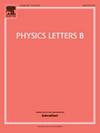de Rham-Gabadadze-Tolley类质量引力中(3+1)维重力星模型的存在性与稳定性
IF 4.3
2区 物理与天体物理
Q1 ASTRONOMY & ASTROPHYSICS
引用次数: 0
摘要
本文讨论了大质量重力背景下(3+1)-D重力星的物理性质。在本研究中,为了得到Mazur和Mottola在第1号报告中提出的gravastar模型,我们求解了一个静态、不带电球体的场方程。la - ur - 01 - 5067 (2001);Mazur和Mottola,纽约州。学会科学。美国101(2004)[945]。我们讨论了包含超相对论性刚性流体的薄壳的长度、能量和熵。以色列匹配标准用于确保内部和外部几何形状的平滑连接。目前在dRGT重力范围内的研究与[arXiv:2302.09690]中描述的真实重力星有明显的根本差异;Mazur和Mottola,同学们。量子力学,32(2015)215024],这要求相变发生在R=2M处。事实证明,引力子质量的存在完全改变了引力星的行为。特别是,当m→0时,我们的发现与广义相对论的结果完全吻合。本文章由计算机程序翻译,如有差异,请以英文原文为准。
Existence and stability of (3+1)-dimensional gravastar model in de Rham–Gabadadze–Tolley like massive gravity
The physical properties of a (3+1)-D gravastar in the context of massive gravity are discussed in this work. In present investigation, the field equations have been solved for a static, uncharged sphere in order to achieve the gravastar model as proposed by Mazur and Mottola [Mazur and Mottola in Report No. LA-UR-01-5067, (2001); Mazur and Mottola, Proc. Natl. Acad. Sci. USA 101 (2004) 9545]. We address length of thin shell, energy, and entropy for the thin shell containing an ultra-relativistic stiff fluid. Israel matching criteria are used to ensure that the inner and outside geometries join smoothly. The present study within dRGT gravity differs markedly and fundamentally from true gravastars described in [arXiv:2302.09690; Mazur and Mottola, Class. Quant. Grav. 32 (2015) 215024], which requires the phase transition occured at . It turns out that the existence of the graviton mass entirely alters the behavior of the gravastar. Particularly, when , our findings precisely matched the outcomes of general relativity.
求助全文
通过发布文献求助,成功后即可免费获取论文全文。
去求助
来源期刊

Physics Letters B
物理-物理:综合
CiteScore
9.10
自引率
6.80%
发文量
647
审稿时长
3 months
期刊介绍:
Physics Letters B ensures the rapid publication of important new results in particle physics, nuclear physics and cosmology. Specialized editors are responsible for contributions in experimental nuclear physics, theoretical nuclear physics, experimental high-energy physics, theoretical high-energy physics, and astrophysics.
 求助内容:
求助内容: 应助结果提醒方式:
应助结果提醒方式:


